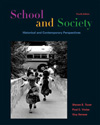 |  School and Society: Historical and Contemporary Perspectives, 4/e Stephen E. Tozer,
The University of Illinois, Chicago
Paul C. Violas
Guy Senese,
Northern Arizona University
Introduction: Understanding School and Society
Chapter OverviewChapter 1 introduces students to the basic analytic vocabulary, or "tools of inquiry," used throughout School and Society, with an emphasis on why social context is important to consider if we are to understand schooling. The common opposition of the "theoretical" and the "practical" is challenged on the grounds that good social theory seeks to identify and explain actual phenomena, including phenomena of practice. It also describes the three-part analytic framework used throughout the book, in which the terms political economy, ideology, and schooling are understood as interactively influencing one another. To illustrate how this framework can be used to interpret the way school and society relate to each other, brief sketches of feudal Europe and classical Athens are presented. These examples should help students explore why it is important to study the history, philosophy, and social context of education, and how such study applies to teaching practice. Finally, the special relationship between democratic values and educational practice, a theme throughout the volume, is introduced. |
|



 2002 McGraw-Hill Higher Education
2002 McGraw-Hill Higher Education